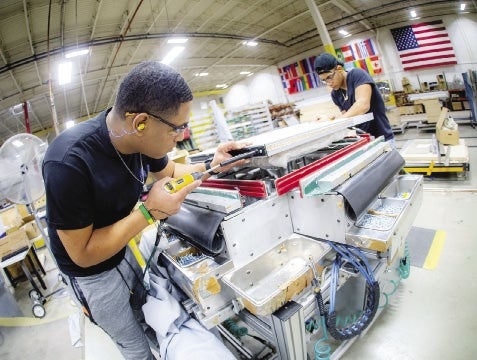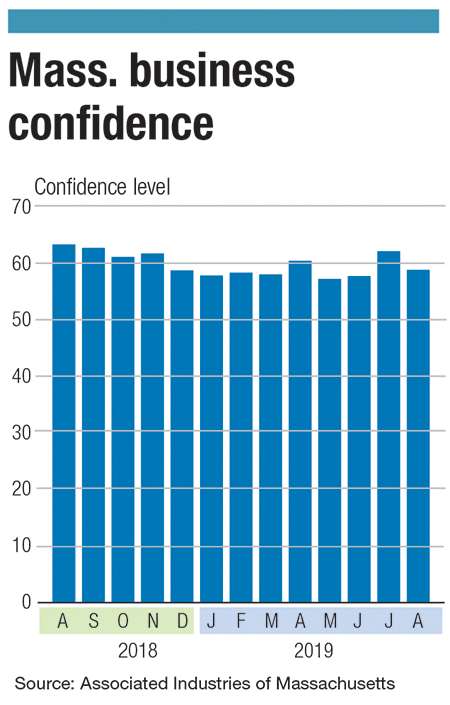
Indicators of a slowing economy are here, but they might not add up to a looming recession
 Workers assemble furniture at AIS in Leominster, which expanded in 2017.
Workers assemble furniture at AIS in Leominster, which expanded in 2017.
Employment declined across the Worcester metropolitan area in the first half of the year, and an index compiled by Assumption College calls for a rebound in the months ahead.
If that picture seems muddy, that can be the nature of economic predictions.
Unemployment rates remain at or near the lowest levels in generations, and stocks generally continue rising. But concerning forecasts on consumer spending, job growth, debt and investments ramped up amid ominous signs and a lingering trade war with China.
“There’s more clouds on the horizon than there used to be, definitely,” said John Brown, an economist at Clark University in Worcester.
Recession talk hit a tipping point of sorts in August when a typically reliable sign of a looming recession – the inverted yield curve – took place: Yields for two-year U.S. Treasury bonds exceeded 10-year bonds, a threshold preceding every recession since 1955.

Since then, American markets have fluctuated based on the latest news – good and bad – on the trade war, including a sharp rise simply on reports about American and Chinese officials meeting sometime in October.
Eric Rosengren, the president of the Federal Reserve Bank of Boston, portrayed conditional confidence in September based on strong consumption making up for other weaknesses.
“If the consumer continues to spend, and global conditions do not deteriorate further,” Rosengren said at a business event at Stonehill College, “the economy is likely to grow around 2%, in part because the underpinnings of consumer growth – household income growth and household wealth – remain strong, and consumption accounts for about 70% of GDP in the U.S.”
Local signs
In Central Massachusetts, indicators give reasons for optimism and worry.
The unemployment rate for the Worcester metropolitan area was 3.3% in July, in the top quarter of all metro areas. But U.S. Bureau of Labor Statistics estimates for the second quarter show the Greater Worcester labor force shrinking by nearly 1,500 workers.
[Related: Worcester metro area returns, barely, to positive job growth]
The Worcester Economic Index, as compiled by Assumption College economics professor Thomas White, shows Greater Worcester's economy contracting by a 0.3% annualized rate in the first quarter of the year and a 0.9% rate in the second quarter.
Still, White projects 1.3% to 1.5% growth in the next six months, based on consumer confidence, new business incorporations and other factors.

Manufacturing is a closely watched economic indicator, and in the Worcester area, such jobs have been slowing. The local industry exceeded national growth after the Great Recession but since late 2017 has lagged, according to data from Washington, D.C. think tank Brookings Institution.
In that time, Greater Worcester's manufacturing employment has grown 1.2%. Nationally, it grew 2.1%.
[Related: Behind for years, Greater Worcester catching up to peers in some important measurements]
Advanced manufacturing in Greater Worcester – higher-technology operations making up a greater share of Greater Worcester's manufacturing industry and potentially more susceptible to a trade war and overseas economic struggles – grew by 0.3% from 2010 to 2018, compared to 1.3% nationally.
But local banking leaders are still largely optimistic. Ed Manzi, the CEO and chairman of Leominster-based Fidelity Bank, said he finds through meetings with clients, realtors and accountants confidence is still up. A call in September with other area community bank executives found no local signs foretelling a recession, he said.
“Right now, everyone’s feeling good,” Manzi said.
Others find it hard to know exactly what factors are best at predicting a recession. Many economic concerns can even be traced simply to the length of the current expansion, which at 10 years is the longest on record, said Robert Baumann, economics professor at the College of the Holy Cross in Worcester.
Among data sets Baumann said he looks at are housing prices and employment. Consumer debt is up – it hit nearly $4.1 trillion in July, an all-time high, even adjusting for inflation – though that could be a sign of confidence just as much as it may be an indicator that people are striving to keep up economically. Either way, it’s a number to keep an eye on, he said.
“It was exactly this kind of problem that got us into the last recession in the first place,” Baumann said.
The broader picture
Today’s economic expansion is the country’s longest on record, but economists will often say that alone is not a reason to expect a recession. Still, a recession at some point is inevitable, and experts have been scouring reports to see when the next one might come.
“Nothing goes up forever, and it’s very natural for the market and the economy to go in cycles,” Steve Ng, a Clark professor and investment banker. “It’s not good nor bad, it’s just very normal.”
The trade war with China regularly makes headlines with eye-popping numbers of the valuation of products being subject – or threatened to be – to tariffs. But the trade war isn’t enough in itself to spur a recession, said Smriti Rao, an economics professor at Assumption College in Worcester.
The stock market itself might not be a great indicator of the likelihood of a recession either, Rao said, calling job numbers a better indicator.
“I don’t think of the stock market as a particularly good indicator of economic health,” she said.
Nationally, most economists expect the U.S. economy to dip into a recession by 2021, if not sooner.
In a survey of more than 200 economists by the National Association of Business Economics, 72% predicted 2020 or 2021 for entering a recession. Two out of five predicted a recession by the end of 2020 or sooner.
[Related: Central Mass. manufacturing no longer outpacing the nation]
Most economists – 83% – said they expect global economic growth in 2019 to be slower than last year’s rate of 3.6%.
Those questions were asked before new tariffs went into effect Sept. 1, prior to the Federal Reserve’s latest rate cut, and before the inverted yield curve passed its threshold show investors had more confidence in the economy in the long run than short term.
The yield curve has predicted recessions before, and Ng said anyone would have to provide a strong reason to think it wouldn’t be the case again this time.
“It could or could not be different, but as an investor, I’m very alarmed,” he said.
If others are worried, they’re not exactly showing it yet: the Dow Jones Industrial Average is up since mid-August, when the market initially tanked but then recovered after the inverted yield flashed a warning sign.

Still, a broad look at other indicators shows at least some cause for concern. They join a group of even more widespread complicating factors, from the federal debt to Brexit to stagnant wages not keeping up with housing, health care, college loans and other costs.
[Related: Worcester area economic activity contracted in first half of the year]
The American economy grew at a 2.1% annual rate in the second quarter, the second lowest rate in three years, the U.S. Bureau of Economic Analysis reported in numbers revised Aug. 29. Residential investment fell for the sixth straight quarter, gross private domestic investment fell by the highest rate in at least three years, and exports fell by a 5.8% annualized rate.
In manufacturing, August showed declines in new orders, production and employment, while a composite index of those and other trends was negative for the first time in 35 months, according to the Institute for Supply Management.
As for consumers, their spending has carried the economy but that may be running out of steam, too. A consumer confidence index published in August by the University of Michigan posted its sharpest monthly decline since December 2012.
Confidence hit the lowest level in nearly three years.









0 Comments